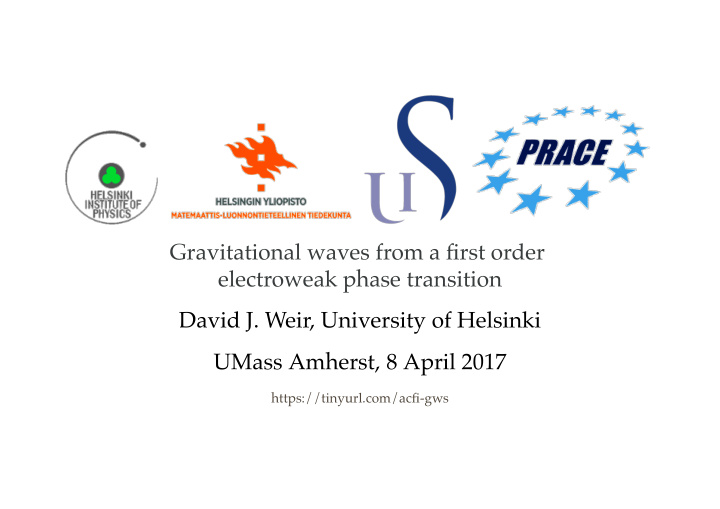



Gravitational waves from a first order electroweak phase transition David J. Weir, University of Helsinki UMass Amherst, 8 April 2017 https://tinyurl.com/acfi-gws
Lots of sources... Source: http://rhcole.com/apps/GWplotter/
LISA Pathfinder Exceeded design expectations by factor of five!
What's next: LISA LISA: three arms (six laser links), 2.5 M km separation Launch as ESA’s third large-scale mission (L3) in (or before) 2034 Proposal officially submitted earlier this year 1702.00786
From the proposal:
First order thermal phase transition: 1. Bubbles nucleate and grow 2. Expand in a plasma - create shock waves 3. Bubbles + shocks collide - violent process 4. Sound waves left behind in plasma 5. Turbulence; expansion
Thermal phase transitions Standard Model is a crossover Kajantie et al ; Karsch et al. ; ... First order possible in extensions (xSM, 2HDM, ...) Andersen et al. , Kozaczuk et al. , Carena et al. , Bödeker et al. , Damgaard et al. , Ramsey-Musolf et al. , Cline and Kainulainen, ... Baryogenesis? GW PS ⇔ model information?
What the metric sees at a thermal phase transition Bubbles nucleate and expand, shocks form, then: 1. : Bubbles + shocks collide - 'envelope phase' 2. : Sound waves set up - 'acoustic phase' 3. : [MHD] turbulence - 'turbulent phase' Sources add together to give observed GW power:
Envelope approximation
Envelope approximation Kosowsky, Turner and Watkins; Kamionkowski, Kosowsky and Turner Thin, hollow bubbles, no fluid Stress-energy tensor on wall Solid angle: overlapping bubbles → GWs Simple power spectrum: One length scale (average radius ) Two power laws ( , ) Amplitude ⇒ 4 numbers define spectral form NB: Used to be applied to shock waves (fluid KE), now only use for bubble wall (field gradient energy)
Envelope approximation 4-5 numbers parametrise the transition: , vacuum energy fraction , bubble wall speed , conversion 'efficiency' into gradient energy Transition rate: , Hubble rate at transition , bubble nucleation rate → ansatz for [only matters for vacuum/runaway transitions]
Envelope approximation
Coupled field and fluid system Ignatius, Kajantie, Kurki-Suonio and Laine Scalar and ideal fluid : Split stress-energy tensor into field and fluid bits Parameter sets the scale of friction due to plasma is a 'toy' potential tuned to give latent heat ↔ number of bubbles; ↔ , ↔ Begin in spherical coordinates: what sort of solutions does this system have?
Velocity profile development: small ⇒ detonation (supersonic wall) 0:00 / 0:25
Velocity profile development: large ⇒ deflagration (subsonic wall) 0:00 / 0:25
as a function of Cutting [Masters dissertation]
Simulation slice example 0:00 / 1:00
Velocity power spectra and power laws Fast deflagration Detonation Weak transition: Power law behaviour above peak is between and “Ringing” due to simultaneous nucleation, unimportant
GW power spectra and power laws Fast deflagration Detonation Causal at low , approximate or at high Curves scaled by : source until turbulence/expansion → power law ansatz for
Transverse versus longitudinal modes – turbulence? Short simulation; weak transition (small ): linear; most power in longitudinal modes ⇒ acoustic waves, turbulent Turbulence requires longer timescales Plenty of theoretical results, use those instead Kahniashvili et al.; Caprini, Durrer and Servant; Pen and Turok; ... → power law ansatz for
Putting it all together - 1512.06239 Three sources, , , Know their dependence on , , , Espinosa, Konstandin, No, Servant Know these for any given model, predict the signal... (example, , , , )
Putting it all together - physical models to GW power spectra Model ( , , , ) this plot ... which tells you if it is detectable by LISA (see 1512.06239 )
Detectability from acoustic waves alone In many cases, sound waves dominant Parametrise by RMS fluid velocity and bubble radius (quite easily obtained Espinosa, Konstandin, No and Servant ) Sensitivity plot:
The pipeline 1. Choose your model (e.g. SM, xSM, 2HDM, ...) 2. Dim. red. model Kajantie et al. 3. Phase diagram ( , ); lattice: Kajantie et al. 4. Nucleation rate ( ); lattice: Moore and Rummukainen 5. Wall velocities ( ) Moore and Prokopec; Kozaczuk 6. GW power spectrum 7. Sphaleron rate Very leaky, even for SM!
Questions, requests or demands... Turbulence MHD or no MHD? Timescales , sound waves and turbulence? More simulations needed? Interaction with baryogenesis Competing wall velocity dependence of BG and GWs? Sphaleron rates in extended models? The best possible determinations for xSM, 2HDM, SM, ... What is the phase diagram? Nonperturbative nucleation rates?
Implementation extra slides
Dynamic range issues Most realtime lattice simulations in the early universe have a single [nontrivial] length scale Here, many length scales important Recently completed simulations with lattices, → approx 1M CPU hours each (17.6M total)
Implementation: special relativistic hydrodynamics Different things live in different places... With this discretisation, evolution is second-order accurate!
Extra, extra slides [click here]
Recommend
More recommend